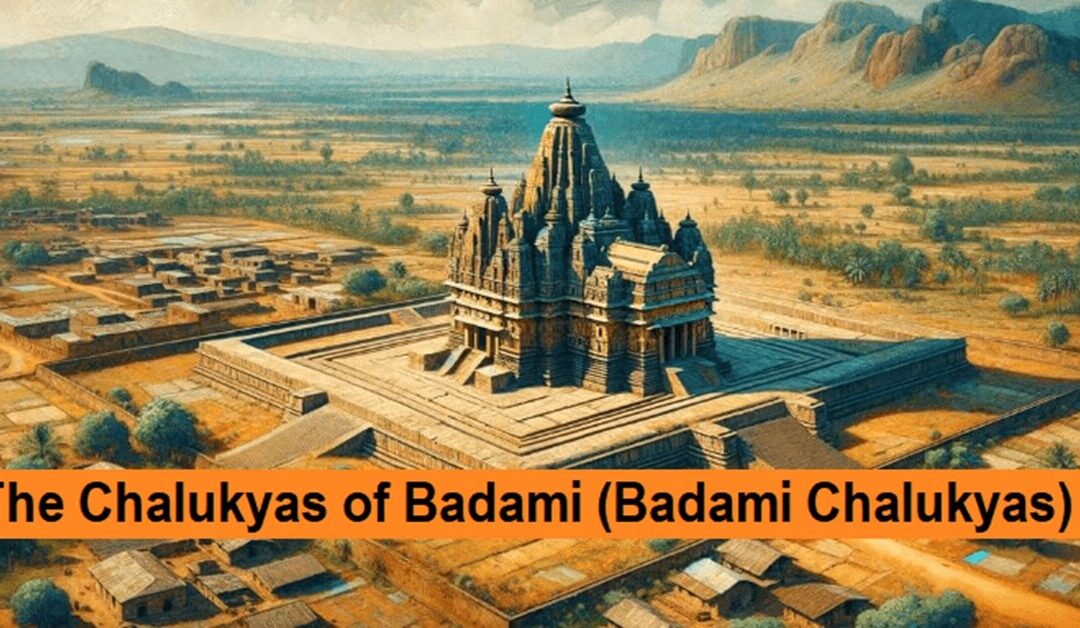Badami Chalukya architecture is a remarkable style of Hindu temple architecture that evolved between the 5th and 8th centuries CE. Emerging in the Malaprabha river basin of present-day Bagalkot district in Karnataka, India, this architectural style left an indelible mark on South Indian history. Known for its unique combination of Dravidian and Nagara styles, Badami Chalukya architecture is sometimes referred to as the Vesara or Chalukya style. Over time, it influenced the later architectural developments in the region, including the Western Chalukya architecture of the 11th and 12th centuries.
Origins and Evolution of Badami Chalukya Architecture
The earliest examples of Badami Chalukya architecture date back to around 450 CE, when the Badami Chalukyas were vassals of the Kadambas of Banavasi. The style was perfected in Badami and Pattadakal, two key centers in Karnataka, where the Chalukya kings commissioned numerous temples.
The architects and artists of this period experimented with various styles, blending the Nagara and Dravidian styles in innovative ways. Badami Chalukya architecture includes two types of monuments: rock-cut temples (cave temples) and structural temples built above ground.
Badami Cave Temples: An Early Masterpiece
The Badami cave temples are some of the most iconic rock-cut structures in South India. These temples feature three basic components: a pillared veranda, a columned hall, and a sanctum carved deep into the rock. Early experiments in rock-cut architecture were first attempted in Aihole, where three cave temples were constructed in Vedic, Buddhist, and Jain styles. However, the style was refined and perfected in Badami, where four magnificent cave temples were built.
One notable feature of the Badami cave temples is the running frieze of Ganas (semi-divine attendants) carved in relief along each plinth, displaying them in various playful postures. While the exterior verandas of these temples remain relatively plain, the interiors are rich with sculptural symbolism, showcasing the mastery of the Chalukya artists.
Art critic Dr. M. Sheshadri praised Chalukya art by noting, “They cut rock like Titans but finished like jewellers,” highlighting their exceptional craftsmanship. The Chalukya cave temples maintain a fine balance between versatility and restraint, as described by critic Zimmer.
Structural Temples of Pattadakal
Pattadakal, located in northern Karnataka, is home to some of the most sophisticated structural temples of the Chalukya dynasty. Among the ten temples at Pattadakal, six are built in the Dravidian style, while four follow the Rekhanagara style. The Virupaksha temple is perhaps the most renowned structure, closely resembling the Kailasanatha temple at Kanchipuram, which predates it by a few years.
The Virupaksha temple is a comprehensive temple complex, featuring a central structure with a Nandi pavilion in front and a walled enclosure entered through a gateway. The sanctum, or main shrine, is accompanied by a Pradakshinapatha (circumambulatory path) and a mantapa (pillared hall). The mantapa is adorned with perforated windows, enhancing the temple’s aesthetic appeal. Art critic Percy Brown noted that the sculptures in the Virupaksha temple “flow into the architecture in a continuous stream,” contributing to the seamless integration of art and architecture.
Revival of Chalukya Architecture in the Vijayanagar Empire
The influence of Badami Chalukya architecture resurfaced centuries later in the pillared architecture of the Vijayanagar Empire. The caves of the Vijayanagar period are replete with finely engraved sculptures of Hindu deities such as Harihara, Trivikrama, Mahisa Mardhini, and others, along with a variety of animal and foliage motifs.
Key Temples of the Badami Chalukyas
The Badami Chalukyas were prolific builders, leaving behind a legacy of magnificent temples across Karnataka. Some of the most important temples associated with the Badami Chalukyas include:
Temples at Pattadakal
- Virupaksha Temple
- Sangameswarar Temple
- Kashivisvanatha Temple (Rashtrakuta)
- Mallikarjuna Temple
- Galganatha Temple
- Kadasiddeshvara Temple
- Jambulinga Temple
- Jain Narayana Temple (Rashtrakuta)
- Papanatha Temple
- Naganatha Temple
- Chandrashekara Temple
Temples at Aihole
- Lad Khan Temple
- Huchiappayyagudi Temple
- Durga Temple
- Meguti Jain Temple
- Ravanaphadi Temple
Temples at Badami
- Cave 1 (Shiva)
- Cave 2 (Vishnu as Trivikrama or Vamana, Varaha, Krishna)
- Cave 3 (Vishnu as Narasimha, Varaha, Harihara, Trivikrama)
- Cave 4 (Jain Tirthankara Parsvanatha)
- Bhutanatha Temples
Art and Architecture of the Chalukyas: A Cultural Revolution
The Chalukyas of Badami played a pivotal role in the evolution of South Indian architecture, known as “Chalukyan architecture” or “Karnata Dravida architecture.” Their legacy includes the construction of over a hundred temples, both rock-cut and structural, primarily in the Malaprabha river basin in Karnataka. This architectural tradition would later influence the art of the Western Chalukyas in the 11th and 12th centuries.
Chalukyan architecture is distinguished by its use of local reddish-golden sandstone, which was carved using a technique known as “subtraction.” The rock-cut cave temples, like those at Aihole and Badami, demonstrate the Chalukyas’ mastery in sculptural design. These temples typically feature a simple exterior but reveal intricately designed interiors, including pillared verandas, columned halls, and shrines carved deep into the rock.
Notable Temples and Structural Innovations
Some of the most renowned temples built by the Chalukyas include:
1. Aihole Temples:
The Lad Khan Temple, Durga Temple, and Huchimalligudi Temple are notable for their distinctive designs, such as the perforated stone windows at Lad Khan and the northern Indian style tower of the Durga Temple.
2. Pattadakal Temples:
The Virupaksha and Papanatha temples stand out for their exceptional fusion of Dravidian and Nagara styles.
3. Mahadeva Temple at Itagi:
Known for its intricate carvings and ornamental design.
The Chalukyan Legacy
The Chalukyan dynasty’s contributions to Indian architecture are unparalleled. The temples and cave complexes they left behind are a testament to their advanced architectural skills, blending both artistic creativity and religious symbolism. The Vesara style they pioneered remains a hallmark of South Indian architecture, influencing later architectural developments during the Vijayanagara Empire and beyond.
Conclusion
The Badami Chalukya dynasty’s legacy in art and architecture continues to captivate historians, architects, and travelers alike. With their innovative blending of Dravidian and Nagara styles, the Chalukyas built some of the most iconic temples in South India. From the rock-cut cave temples of Badami to the grand structural temples of Pattadakal, the Badami Chalukya architecture stands as a proud testament to the creativity, craftsmanship, and devotion of this ancient dynasty.
Today, these architectural wonders not only offer a glimpse into the past but also serve as symbols of the Chalukyas enduring influence on the cultural and architectural landscape of India.


